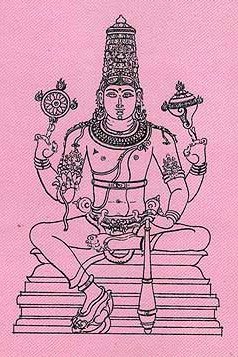Visarjana: 21 definitions
Introduction:
Visarjana means something in Buddhism, Pali, Hinduism, Sanskrit, Marathi, Hindi. If you want to know the exact meaning, history, etymology or English translation of this term then check out the descriptions on this page. Add your comment or reference to a book if you want to contribute to this summary article.
Alternative spellings of this word include Visarjan.
In Hinduism
Purana and Itihasa (epic history)
Source: archive.org: Shiva Purana - English Translation1) Visarjana (विसर्जन) refers to “mystical discharge and conclusion” and represents one of the sixteen upacāra, or “sixteen types of homage and services”, as described while explaining the mode of worshipping the phallic form (liṅga) of Śiva in the Śivapurāṇa 1.11. Accordingly, “[...] the devotee shall worship the mobile emblem with the sixteen types of homage and services (upacāra) as prescribed. It accords the region of Śiva gradually. The sixteen types of service are [for example, mystical discharge and conclusion (visarjana)] [...] Or he shall perform all the sixteen rites in the phallic emblem of human, saintly or godly origin, or in one naturally risen up (svayambhū) or in one of very extraordinary nature installed duly”.
Visarjana (ritualistic farewell) is also mentioned in the Śivapurāṇa 1.20, while explaining the mode of worshipping an earthen phallic image (pārthiva-liṅga) according to the Vedic rites:—“[...] Pañcāṅgapāṭha shall then be performed by the Vedic scholar. Then Visarjana (ritualistic farewell) shall be performed with the mantra ‘Devā gātu’ etc.”.
2) Visarjana (विसर्जन) refers to “casting of (one’s body)” (in the midst of enjoyment), according to the Śivapurāṇa 2.5.5 (“The Tripuras are fascinated).—Accordingly, as Arihan said to the Lord of the Three Cities: “O ruler of the Asuras, listen to my statement, pregnant with wisdom. It is the essence of the Vedānta and bears high esoteric importance. [...] Living beings have heaven and hell here itself and not anywhere else. Happiness is heaven and misery is hell. If the body is cast off (deha-visarjana) in the midst of enjoyment that is the greatest liberation conceived by the philosophers. When pain comes to an end along with its impressions, If ignorance too dies away, it is conceived as the greatest salvation by the philosophers. [...]”.
Source: Cologne Digital Sanskrit Dictionaries: The Purana IndexVisarjana (विसर्जन).—A Yadu tribe; ended their lives by killing their kinsmen.*
- * Bhāgavata-purāṇa XI. 30. 18.

The Purana (पुराण, purāṇas) refers to Sanskrit literature preserving ancient India’s vast cultural history, including historical legends, religious ceremonies, various arts and sciences. The eighteen mahapuranas total over 400,000 shlokas (metrical couplets) and date to at least several centuries BCE.
Pancaratra (worship of Nārāyaṇa)
Source: archive.org: Isvara Samhita Vol 5Visarjana (विसर्जन) or Visarjanamudrā is the name of a mudrā described in the Īśvarasaṃhitā 70-71.—Accordingly, “the fingers of both the hands should be made to look like the sword and be kept apart. The thumbs are to (be raised) be made to look like sticks and gradually form into fists starting from the little finger. This is the mudrā for farewell”.
Mūdra (eg., Visarjana-mudrā) is so called as it gives joy to the tattvas in the form of karman for those who offer spotless worship, drive out the defects which move about within and without and sealing up of what is done.

Pancaratra (पाञ्चरात्र, pāñcarātra) represents a tradition of Hinduism where Narayana is revered and worshipped. Closeley related to Vaishnavism, the Pancaratra literature includes various Agamas and tantras incorporating many Vaishnava philosophies.
Kavya (poetry)
Source: Brill: Śaivism and the Tantric Traditions (kavya)Visarjana (विसर्जन) refers to “laying off (one’s body)”, according to Kālidāsa’s Raghuvaṃśa verse 8.26.—Accordingly: “When he heard that his father had laid off his body (deha-visarjana), Raghu’s son shed tears for a long time, and then performed the final sacrifice of that Indra of the earth together with the chaplain”.

Kavya (काव्य, kavya) refers to Sanskrit poetry, a popular ancient Indian tradition of literature. There have been many Sanskrit poets over the ages, hailing from ancient India and beyond. This topic includes mahakavya, or ‘epic poetry’ and natya, or ‘dramatic poetry’.
Shaivism (Shaiva philosophy)
Source: SOAS University of London: Protective Rites in the Netra TantraVisarjana (विसर्जन) refers to the “cessation” (of differentiation), according to the Netratantroddyota commentary on the Netratantra of Kṣemarāja: a Śaiva text from the 9th century in which Śiva (Bhairava) teaches Pārvatī topics such as metaphysics, cosmology, and soteriology.—Accordingly, [verse 8.4.7, while describing the purification process of the initiand]—“Next, after [the Mantrin has] caused the cessation, etc. (visarjana—visarjanādi kṛtvā) [of differentiation], as taught of the eight-fold subtle body through the offerings of inviting, reverence and oblation, [and] after he has purified all the paths, after he has first united [the initiand] with all the other tattvas, beginning with kalā, he should then] cut off of the topknot and perform homa. [...]”.

Shaiva (शैव, śaiva) or Shaivism (śaivism) represents a tradition of Hinduism worshiping Shiva as the supreme being. Closely related to Shaktism, Shaiva literature includes a range of scriptures, including Tantras, while the root of this tradition may be traced back to the ancient Vedas.
Dharmashastra (religious law)
Source: Oxford Academic: Homo Ritualis: Hindu Ritual and Its Significance to Ritual TheoryVisarjana (विसर्जन) refers to the “removal of holy items” (e.g., releasing the sacred vases), and represents one of the elements of Newar rituals.—Books such as the Daśakarmavidhi detail on the most common rules to be followed by the Newar priests, the priest’s clients, or the clan’s oldest men or women who are mostly ritually responsible for the ritual, and the individual(s) for whom the life-cycle ritual is performed.—The Āśīrvāda rite is mentioned under the heading “Concluding rites”.

Dharmashastra (धर्मशास्त्र, dharmaśāstra) contains the instructions (shastra) regarding religious conduct of livelihood (dharma), ceremonies, jurisprudence (study of law) and more. It is categorized as smriti, an important and authoritative selection of books dealing with the Hindu lifestyle.
Ganapatya (worship of Ganesha)
Source: archive.org: Shiva Purana - (Ganesha)Visarjana (विसर्जन) refers to the “rites of formal dismissal” (performed during the worship of Gaṇeṣa), according to the Śivapurāṇa 2.4.18 (“Gaṇeśa crowned as the chief of Gaṇas”).—Accordingly, as Śiva said to Gaṇeśa: “[...] The devotee shall keep awake at night and perform worship in the morning. After that the rites of formal dismissal (visarjana) with the mantra ‘kṣemāya punarāgamanāya ca’ (For welfare and return again) shall be performed. The benediction as well as good wishes shall be received from the boy. In order to make the Vrata complete, handfuls of flowers shall be offered. [...]”.
Ganapatya (गाणपत्य, gāṇapatya) represents a tradition of Hinduism where Ganesha is revered and worshipped as the prime deity (ishta-devata). Being a minor though influential movement, Ganapatya evovled, llike Shaktism and Shaivism, as a separate movement leaving behind a large body of literature.
In Buddhism
Tibetan Buddhism (Vajrayana or tantric Buddhism)
Source: OSU Press: Cakrasamvara SamadhiVisarjana (विसर्जन) refers to “dismissal”, according to the Guru Mandala Worship (maṇḍalārcana) ritual often performed in combination with the Cakrasaṃvara Samādhi, which refers to the primary pūjā and sādhanā practice of Newah Mahāyāna-Vajrayāna Buddhists in Nepal.—Accordingly, “Oṃ you have done the aim of all beings, granting the success that follows, Go away, to disperse in the Buddha sphere and return again! Oṃ Āḥ Hūṃ dismissal (visarjana) of the Vajramaṇḍala Mūḥ”.

Tibetan Buddhism includes schools such as Nyingma, Kadampa, Kagyu and Gelug. Their primary canon of literature is divided in two broad categories: The Kangyur, which consists of Buddha’s words, and the Tengyur, which includes commentaries from various sources. Esotericism and tantra techniques (vajrayāna) are collected indepently.
Mahayana (major branch of Buddhism)
Source: De Gruyter: A Buddhist Ritual Manual on AgricultureVisarjana (विसर्जन) refers to “dismissal” (as part of an offering ritual), according to the Vajratuṇḍasamayakalparāja, an ancient Buddhist ritual manual on agriculture from the 5th-century (or earlier), containing various instructions for the Sangha to provide agriculture-related services to laypeople including rain-making, weather control and crop protection.—Accordingly, [as the Bhagavān teaches the offering of the root spell], “[...] Having placed a Nāga facing east, the spell-master should sit down facing that, and should perform invitation, offering of flower and incense and dismissal (visarjana) with the mantra. Then the spell-master should do recitation for 1,008 times. [...]”.

Mahayana (महायान, mahāyāna) is a major branch of Buddhism focusing on the path of a Bodhisattva (spiritual aspirants/ enlightened beings). Extant literature is vast and primarely composed in the Sanskrit language. There are many sūtras of which some of the earliest are the various Prajñāpāramitā sūtras.
Languages of India and abroad
Marathi-English dictionary
Source: DDSA: The Molesworth Marathi and English Dictionaryvisarjana (विसर्जन).—n (S) Abandoning, quitting, giving up or letting go. Ex. of comp. gōvisarjana, kūpavisarjana, prāṇavisarjana, bāṇavisarjana, malavisarjana, mūtravisarjana. 2 Dismissing, despatching, sending away. Ex. dēvatāvisarjana, sabhāvisarjana.
Source: DDSA: The Aryabhusan school dictionary, Marathi-Englishvisarjana (विसर्जन).—n Abandoning, dismissing.
Marathi is an Indo-European language having over 70 million native speakers people in (predominantly) Maharashtra India. Marathi, like many other Indo-Aryan languages, evolved from early forms of Prakrit, which itself is a subset of Sanskrit, one of the most ancient languages of the world.
Sanskrit dictionary
Source: DDSA: The practical Sanskrit-English dictionaryVisarjana (विसर्जन).—
1) Emitting, sending forth, pouring down; समतया वसुवृष्टिविसर्जनैः (samatayā vasuvṛṣṭivisarjanaiḥ) R.9.6.
2) Giving away, a gift, donation; R.9.6.
3) Voiding; वाष्वग्निविप्रमादित्यमपः पश्यंस्तथैव गाः । न कदाचन कुर्वीत बिण्मूत्रस्य विसर्जनम् (vāṣvagnivipramādityamapaḥ paśyaṃstathaiva gāḥ | na kadācana kurvīta biṇmūtrasya visarjanam) || Manusmṛti 4.48.
4) Casting off, quitting, abandoning; श्रुतदेहविसर्जनः पितुः (śrutadehavisarjanaḥ pituḥ) R.8.25.
5) Sending away, dismissal.
6) Allowing (the deity invoked) to go (opp. āvāhana).
7) Setting a bull at liberty on certain occasions.
8) Driving out (cows to pasture).
9) Product, creation.
Derivable forms: visarjanam (विसर्जनम्).
Source: Cologne Digital Sanskrit Dictionaries: Shabda-Sagara Sanskrit-English DictionaryVisarjana (विसर्जन).—n.
(-naṃ) 1. Gift, donation. 2. Quitting, relinquishing. 3. Sending, dispatching. 4. Dismissing, sending away. 5. Throwing the image, &c. into holy water, as the concluding rite of the festival of a deity. E. vi before sṛj to let go, aff. lyuṭ .
Source: Cologne Digital Sanskrit Dictionaries: Benfey Sanskrit-English DictionaryVisarjana (विसर्जन).—i. e. vi-sṛj + ana, n. 1. Relinquishing, [Nala] 10, 15. 2. Sending away, dismissing,
Visarjana (विसर्जन).—[neuter] cessation, end; making cease, remove; letting go, dismission etc. = [preceding] as far as creation.
Source: Cologne Digital Sanskrit Dictionaries: Monier-Williams Sanskrit-English Dictionary1) Visarjana (विसर्जन):—[=vi-sarjana] [from vi-sṛj] m. [plural] Name of a family, [Bhāgavata-purāṇa]
2) [=vi-sarjana] [from vi-sṛj] n. cessation, end, [Ṛg-veda; ???; Harivaṃśa]
3) [v.s. ...] relaxation (of the voice), [Vājasaneyi-saṃhitā; Śatapatha-brāhmaṇa]
4) [v.s. ...] evacuation, [Ṛg-veda]
5) [v.s. ...] abandoning, deserting, giving up, [Mahābhārata; Raghuvaṃśa]
6) [v.s. ...] discharge, emission, [Manu-smṛti; Raghuvaṃśa]
7) [v.s. ...] sending forth, dismissal, [Yājñavalkya; Mahābhārata] etc.
8) [v.s. ...] driving out (cows to pasture), [Vāsavadattā, [Introduction]]
9) [v.s. ...] throwing (the image of a deity into holy water, as the concluding rite of a festival), [Catalogue(s)]
10) [v.s. ...] setting (a bull) at liberty (on [particular] occasions), [Monier-Williams’ Sanskrit-English Dictionary]
11) [v.s. ...] giving, bestowing, [Kāvya literature]
12) [v.s. ...] hurting, casting, shooting, [Rāmāyaṇa]
13) [v.s. ...] creating, [Ṛg-veda]
14) [v.s. ...] product, creation, [Bhāgavata-purāṇa]
15) [v.s. ...] answering a question, [cf. Lexicographers, esp. such as amarasiṃha, halāyudha, hemacandra, etc.]
Source: Cologne Digital Sanskrit Dictionaries: Yates Sanskrit-English DictionaryVisarjana (विसर्जन):—[vi-sarjana] (naṃ) 1. n. Gift; quitting; sending.
Source: DDSA: Paia-sadda-mahannavo; a comprehensive Prakrit Hindi dictionary (S)Visarjanā (विसर्जना) in the Sanskrit language is related to the Prakrit word: Visajjaṇā.
[Sanskrit to German]
Sanskrit, also spelled संस्कृतम् (saṃskṛtam), is an ancient language of India commonly seen as the grandmother of the Indo-European language family (even English!). Closely allied with Prakrit and Pali, Sanskrit is more exhaustive in both grammar and terms and has the most extensive collection of literature in the world, greatly surpassing its sister-languages Greek and Latin.
Hindi dictionary
Source: DDSA: A practical Hindi-English dictionaryVisarjana (विसर्जन) [Also spelled visarjan]:—(nm) dispersal; abandonment; ~[rjana karanā] to disperse; to abandon; ~[rjita] dispersed; abandoned.
...
Kannada-English dictionary
Source: Alar: Kannada-English corpusVisarjana (ವಿಸರ್ಜನ):—
1) [noun] the act of abandoning, reliquishing; abandonment; relinquishment.
2) [noun] anything that is given (as a gift).
3) [noun] the formal sending off of a deity who was installed in an idol for temporary period (as during a festival).
4) [noun] a discharging of urine, faeces, etc. from the body.
5) [noun] (dance.) one of the twenty actions of the hand, expressing abandoning, relinquishing.
Kannada is a Dravidian language (as opposed to the Indo-European language family) mainly spoken in the southwestern region of India.
See also (Relevant definitions)
Starts with: Visarjanamga, Visarjanamudra.
Ends with: Avahanavisarjana, Dehavisarjana, Malavisarjana, Sakhyavisarjana, Vagvisarjana, Vratavisarjana.
Full-text (+13): Vaisarjana, Dehavisarjana, Malavisarjana, Ahvanana, Kankanavicarccanam, Visarjani, Visajjana, Visarjaniya, Dehatyaga, Vagvisarjana, Anvarambhana, Vratavisarjana, Vicarccanam, Visarjane, Visarjan, Sakhyavisarjana, Visarjanem, Samharamudra, Prasarpa, Mal.
Relevant text
Search found 17 books and stories containing Visarjana, Vi-sarjana, Visarjanā; (plurals include: Visarjanas, sarjanas, Visarjanās). You can also click to the full overview containing English textual excerpts. Below are direct links for the most relevant articles:
Garga Samhita (English) (by Danavir Goswami)
Verse 6.18.37 < [Chapter 18 - In the Course of Describing the Glories of Siddhāśrama, a Description of the Rāsa-dance Festival]
Manusmriti with the Commentary of Medhatithi (by Ganganatha Jha)
Verse 4.48 < [Section IX - Personal Cleanliness]
Verse 3.205 < [Section XIII - Order of Sequence]
Later Chola Temples (by S. R. Balasubrahmanyam)
Temples in Tidaavur (Tadavur) < [Chapter XII - Temples of Kulottunga III’s Time]
Chaitanya Bhagavata (by Bhumipati Dāsa)
Verse 2.6.110 < [Chapter 6 - The Lord’s Meeting with Advaita Ācārya]
Early Chola Temples (by S. R. Balasubrahmanyam)
Muktesvaram < [Chapter XIV - Conclusion]
Varahi Tantra (English Study) (by Roberta Pamio)
Chapter 30 - Conclusion of the exposition on Durgāpūjā < [Summary of the Vārāhī Tantra]